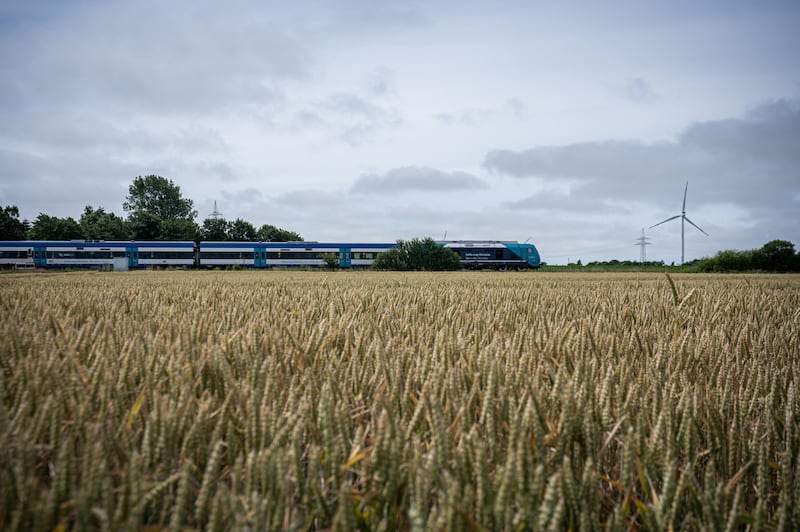Bärbel Hell, who does not usually travel by rail, was delighted to discover that the lumbering blue-and-white regional train she had boarded one early afternoon was not too packed. Even though it was summer, and even though the line she was on connects Germany’s second largest city, Hamburg, with the country’s most exclusive resort destination, the island of Sylt, the coach was not overcrowded. “It was easy — we found these seats right away,” she said.
Hell, returning home from a July shopping trip to Hamburg with friends, had been bracing for much worse — not only because of vacation season, but also because of a special pricing program from Germany’s national rail service that many here had been sceptical of. For the summer months of June, July and August, in a bid to help offset the inflationary pressures on so many of life’s other essential items, especially energy, the country’s government has been subsidising all-you-can-ride monthly public-transport passes for only €9.
This is one of the greatest things that Germany has thought about in recent years — I would almost say decades
“I think it helps a lot,” says Hell, a 67-year-old retiree. “It gives people the chance to get away — because who can afford that with petrol prices these days?”
For all of the appeal of the low price, many German train regulars, who have long had to deal with delayed or cancelled trips and overcrowded cars, were dreading the expected effect of the promotion.
Fintan O’Toole: Five years after Covid, we scorn health workers, ignore vaccines and work in our offices
Fiddler Martin Hayes: ‘I come to the table with whatever little bit I managed to bring off the side of the mountain’
Gordon D’Arcy: Shaun Edwards makes a compelling case for the defence in France’s victory
While it promised to make train travel much more affordable — putting hundreds of euros back in the pockets of regular commuters — it also loomed as a burden that could break a system already at its limit.
Before the tickets were even valid, the country’s tabloids were predicting “€9 chaos” in their headlines.
But the result so far, 10 weeks into the experiment, has been something in rare supply in recent days: a mildly pleasant surprise.
Despite the fact that about a full quarter of Germany’s population bought tickets during the first month of the promotion, the passenger surge has turned out to be less problematic than many anticipated.

Instead, the offer, despite an occasional overcrowded train, has become popular. A recent poll conducted for Der Spiegel, a German newsmagazine, found 55 per cent of all Germans in favour of extending the program, with 34 per cent against.
“This is one of the greatest things that Germany has thought about in recent years — I would almost say decades,” says Felix Lobrecht, a well-known German comic and social observer, who by his own admission prefers his Mercedes to trains.
However, regulars on the train from Hamburg to Westerland, the main town on Sylt, were not ready to declare the plan an unqualified success, nor were they in a mood to forgive some of the past transgressions of Germany’s train network.
It’s the first, and maybe only, measure in this energy crisis that has been categorically accepted
“You saw a definite increase in travellers,” says Matthias Carstensen, who is 27 and on his way to his job at the only McDonald’s on Sylt, which sits in the North Sea about 6.5km off the mainland, to which it is connected by a rail causeway.
But Carstensen, who has been commuting to work at various jobs on the island for a decade, said the bigger problem was the many delays that had plagued the system even before the introduction of the ticket. “Recently, it’s been really bad,” he says.
Over the past couple of years, the number of trains that have arrived on time has plummeted. While it was nearly 90 per cent in 2020, now fewer than two-thirds of the trains pull into stations on time. The number of trains that are cancelled altogether has increased, too.

The biggest shares of the blame lie with ageing infrastructure and rising demand. Even before the summer promotion, the 3,000km of tracks most used by passenger trains were running at 125 per cent capacity.
The €9 ticket — courtesy of a €2.5 billion federal subsidy — was meant as a response to sharply rising energy costs caused in part by Russia’s invasion of Ukraine. But despite its temporary nature, the ticket promotion has become part of a larger discussion about how to make German society more sustainable and less dependent on Russian oil, through policies including encouraging the use of public transportation.
“It’s the first, and maybe only, measure in this energy crisis that has been categorically accepted,” said Luisa Neubauer, one of Germany’s best-known climate activists, noting that the measure helps people from different socioeconomic backgrounds more equitably than subsidies on gas or heating do. “It’s been a huge success.”
Modern German passenger trains generally belong to one of two service tiers.
The high-speed network that the country started expanding in the 1990s connects large cities that, by German standards, are far apart. Travellers can pay as much as an airline ticket for the service, but perks include an on-board restaurant, reclinable seats and internet. When these trains deliver as promised, they can make the trip from Berlin to Munich in under four hours.

The workhorses of Germany’s rail system, however, are the more bare-bones regional trains.
Like the six-car Sylt-bound train rambling amid the flat wheat fields and wind turbines at a maximum speed of about 100km/h, they cover routes of up to several hundred kilometres, connecting neighbouring cities or urban zones with their surrounding suburbs. These are the trains that — together with urban public transportation — can be used anywhere at any time for €9 a month this summer.
At least one group of train employees, conductors, has identified a real benefit from the promotion. Because it is now so rare for somebody to use the train without paying, many conductors have stopped checking for tickets.
“We don’t have to deal with fare dodgers any more,” said one conductor on the Hamburg-Westerland line, who asked not to be identified because he was not allowed to speak to the news media. “Apparently everyone has €9 to spare.” — This article originally appeared in The New York Times





















